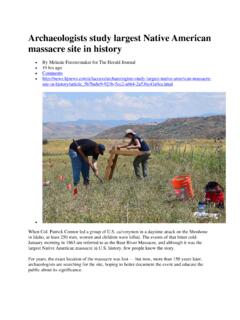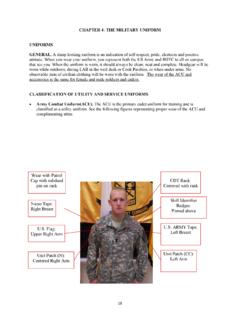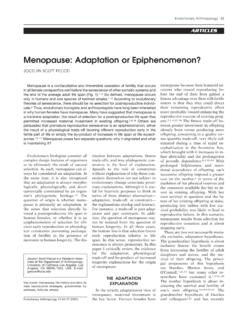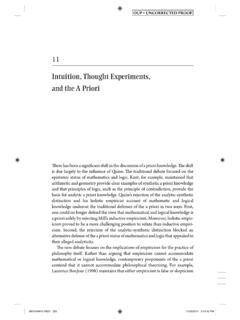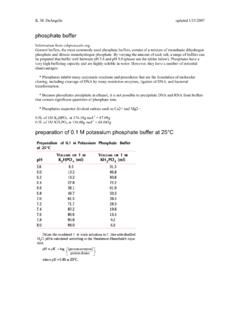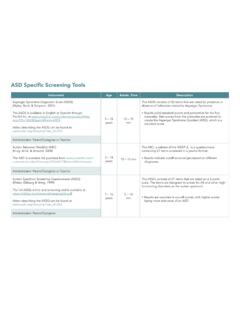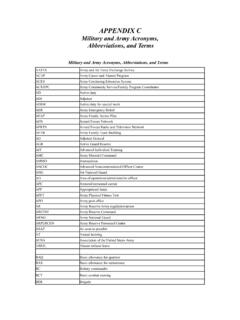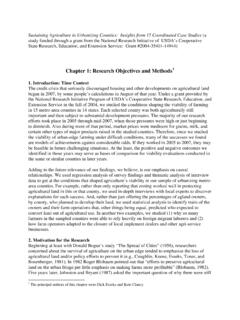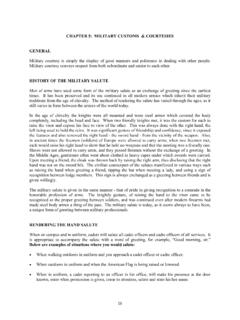Transcription of CHAPTER 9: DRILL AND CERMONY DRILL PROCEDURES
1 Page70 CHAPTER 9: DRILL AND CERMONY DRILL PROCEDURES Many DRILL PROCEDURES used by the United States Army today were developed during the Revolutionary War. The purpose of the DRILL then was to instill discipline in American soldiers. As these soldiers mastered the art of the DRILL , they began to work as a team and to develop a sense of pride in themselves and in their unit. In today s Army, the same objectives teamwork, confidence, pride, alertness, attention to detail, esprit de corps, and discipline are accomplished by DRILL . A DRILL consists of a series of movements by which movements by which a unit or individuals are moved in an orderly, uniform manner from one formation to another move a unit or individuals in an orderly, uniform manner from one formation to another or from one place to another.
2 Units vary in size, but in basic combat training (BCT), you will ordinarily be part of a squad, section, platoon, or company. Figure 9-1, illustrates some DRILL formations. You will need to know the following DRILL terms: Element: This is an individual, squad, section, platoon, company, or larger unit formed as part of the next higher unit. Formation: This is an arrangement of the unit s elements in a prescribed manner such as a line formation, in which the elements are side-by-side, and column formation, in which the elements are one behind the other.
3 In a platoon column, the members of each squad are one behind the other with the squads abreast. Front: This is a space from one side to the other side of a formation, and includes the right and left elements. Figure 9-1. DRILL Formations (without weapons) 57 Page71 Depth: This is a space from the front to the rear of a formation, including the front and rear elements. Distance: This is the space between elements that are one behind the other. The distance between individuals is an arm s length plus 6 inches, or approximately 36 inches, measured from the chest of one soldier to the back of the soldier immediately to his or her front.
4 Interval: This is the space between side-by-side elements. Rank: This is a line that is only one element in depth. File: This is a column that has a front of one element. Guide: This is the person responsible for maintaining the prescribed direction and rate of march. Post: This is the correct place for an officer or noncommissioned officer to stand in a prescribed formation. Head: This is a column s leading element. Base: This is the element around which a movement is planned or regulated. Cadence: This is a uniform rhythm or number of steps or counts per minute.
5 Quick Time: This is a cadence of 120 counts (steps per minute). Double Time: This is a cadence of 180 counts (steps per minute). DRILL commands are oral orders given by your commander or leader, usually in two parts. The preparatory command states the movement to be carried out and gets you ready to execute the order. The command of execution tells when the movement is to be carried out. In the command Forward, march, the preparatory command is Forward, and the command of execution is March. In some commands, the preparatory command and the command of execution are combined, for example, Fall in , At ease, and Rest.
6 These commands are given without inflection and at a uniformly high pitch and loudness comparable to that of a normal command of execution STATIONARY MOVEMENT Attention: Figure 9-2 illustrates the position of attention. You should assume this position on the command Fall in or Squad/Platoon, attention . Your weight should be distributed equally on the heels and balls of your feet. When you come to attention, bring your heels together smartly with your toes forming a 45 degree angle, as shown in Figure 2-2. keep your legs straight without locking your knees. Hold your body erect with your hips level, your chest lifted, and your shoulders square and even.
7 Your arms should hang straight , but not stiff, with the backs of your hands outward. Curl your fingers so that the tips of our thumbs are alongside and touching the first joint of the forefingers. Your thumbs should be straight and along the seams of your trousers or skirt. The first joint of your forefingers should touch the trousers or skirt. keep your head erect, and look straight to the front. 58 Page72 Practice assuming the position of attention so you can do it properly. All movements except rest movements start from this position. Parade Rest: The command to assume this position is Parade, rest.
8 Parade rest is commanded only from the position of attention (Figure 9-2). On the command of execution, Rest , move your left foot l0 inches to the left of your right foot. Rest your weight equally on the heels and balls of both feet, keeping your legs straight without locking your knees. At the same time you move your feet, place your hands at the small of the back, centered on your belt. keep the fingers of both hands extended and joined, interlocking your thumbs, as shown in Figure 9-2, so That the palm of your right hand is outward.
9 Hold your head erect and look straight to the front. Remain silent and do not move. If you are at the position of at ease, stand at ease, or rest, you should assume the parade rest position on hearing the preparatory command for attention. Stand at Ease: The stand at ease position is like parade rest, but with your head and eyes turned directly toward the commander. The command for this position is Stand at ease. At ease or Rest may be commanded from this position. At Ease: The command for this movement is At ease. On the command At ease, the soldier may move; however, he or she must remain standing and silent with his or her right foot in place.
10 Rest: The command for this movement is Rest . On the command Rest , the soldier may move, talk, smoke, or drink from a canteen unless otherwise directed. He or she must remain standing with his or her right foot in place. At ease may be executed from this position. Face to the Flank: Facing to the flank is a two-count movement for turning to one side or the other. The command is Left, face or Right, face . Figure 9-3 illustrates Left face . On the command of execution, Face , slightly raise your right heel and left toe and, with slight pressure on the ball of your right foot, turn yourself 90 degrees to the left on your left heel.
